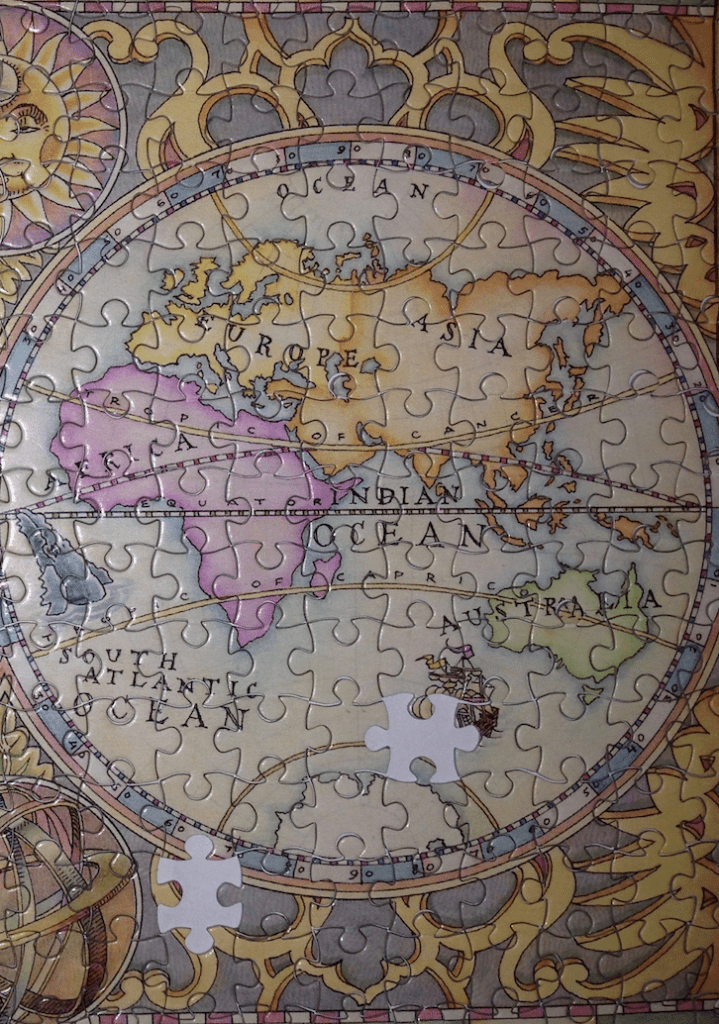Julia Nguyen
Phoenix, Arizona, USA
 |
| (Photo credit to Geetika Gupta) |
Imagine yourself browsing the Entertainment section at the local store. Of all the sections you could possibly be in—Beauty, Grocery, Household, Pharmacy—here you are at the Entertainment section, looking for a jigsaw puzzle. There are so many choices: outdoor scenery or abstract? A 1,000-piece puzzle or just 500? Whatever you choose, you know the ultimate end-point—that image on the box you are trying to achieve. The goal is to complete the puzzle in its entirety in a way that most resembles the original image.
Working on a jigsaw puzzle is similar in this way to the study of medicine. People who choose the medical profession have a strong interest in the field; but even within the field there are many choices. Do we want to be allergists or cardiologists? Generalists or subspecialists? How long are we willing to train? Whatever field in medicine we choose, we know the ultimate end-point—to care for and to heal our patients.
You decide to go for the 1,000-piece jigsaw puzzle with a big field of wildflowers. Do you begin with the edges and move inward, or with a central focus and move outward from there? Maybe you piece together whatever you can until you have several larger multifocal fragments of the image. How will you keep track of the remaining pieces? You could separate them by color, foreground, background, subject, or shape . . . there are no correct or incorrect ways to piece together a jigsaw puzzle, though certain methods may be more organized and therefore more efficient. Your only limitation is time.
Much like piecing together a jigsaw puzzle, there are many options in treating a patient. When a patient arrives with several different complaints, do we address the main complaint first and try to resolve it before moving onto the next complaint? Or start with a single symptom that we suspect may be causing the rest of the symptoms? Perhaps we try to address them all in the same visit, but how will we monitor progress? Follow-up visits or test results may confirm or deny a diagnosis . . . there are many ways to go about treating this patient.
As this jigsaw puzzle progresses, you run into a not-so-small problem. The background seems indistinguishable—blurry with the same mixture of colors. One area of grass looks the same as another, and there are so many pieces that could fit into that grassy area. How is it possible to continue when all these grassy pieces look so similar to one another? Do you try every single piece to look for the perfect fit? One of these remaining pieces has to be a match, so trying them all will eventually yield the correct one. But is that really efficient? Or do you try only green pieces with a specific shape or shade?
Patients may also present with a multitude of vague symptoms. How can we narrow it down to a short list of possible diagnoses? Do we perform every special test, order every single lab and imaging study until we find an abnormality? Undoubtedly, one of these modalities will be able to tell us where the problem lies that is causing these symptoms. But is that efficient, in terms of cost and time?
As you come to finishing the puzzle, you realize that the final piece is missing. Where could it be? Maybe the puzzle came like that—with a missing piece. Or maybe the remaining piece has gotten lost in the box. Perhaps you lost it along the way because it has been a long journey to completion. And the question then is still, “What next?”
Like the missing piece of the jigsaw puzzle, one could easily miss a critical detail in working up a patient, completely misdiagnosing a patient’s condition. Maybe there was something that we never thought to ask. Maybe we missed a physical finding during the examination. Perhaps we overlooked a lab abnormality. But the question remains, “What next?”
Physicians are human, and we are not built to be perfect. We may order unnecessary labs and imaging, trying to get to the real problem in our patients but causing a financial strain. We may miss important findings that could compromise their health. It is inevitable. However, if we can truly say to ourselves that we have worked to the best of our ability and training, then we should feel satisfied, even if the puzzle remains incomplete.
JULIA NGOC-KIM NGUYEN is a current student at the University of Arizona, College of Medicine, Phoenix.

Leave a Reply